The History, Status, and Future of FPGAs:
Hitting a nerve with field-programmable gate arrays
This article is a summary of a three-hour discussion at Stanford University in September 2019 among the authors. It has been written with combined experiences at and with organizations such as Zilog, Altera, Xilinx, Achronix, Intel, IBM, Stanford, MIT, Berkeley, University of Wisconsin, the Technion, Fairchild, Bell Labs, Bigstream, Google, DIGITAL (DEC), SUN, Nokia, SRI, Hitachi, Silicom, Maxeler Technologies, VMware, Xerox PARC, Cisco, and many others. These organizations are not responsible for the content, but may have inspired the authors in some ways, to arrive at the colorful ride through FPGA space described above.
Securing the Boot Process:
The hardware root of trust
The goal of a hardware root of trust is to verify that the software installed in every component of the hardware is the software that was intended. This way you can verify and know without a doubt whether a machine’s hardware or software has been hacked or overwritten by an adversary. In a world of modchips, supply chain attacks, evil maid attacks, cloud provider vulnerabilities in hardware components, and other attack vectors it has become more and more necessary to ensure hardware and software integrity.
A Conversation with Mary Lou Jepsen:
What’s behind that funky green machine?
From Tunisia to Taiwan, Mary Lou Jepsen has circled the globe in her role as CTO of the OLPC (One Laptop Per Child) project. Founded by MIT Media Lab co-founder Nicholas Negroponte in 2005, OLPC builds inexpensive laptops designed for educating children in developing nations. Marvels of engineering, the machines have been designed to withstand some of the harshest climates and most power-starved regions on the planet. To accomplish this, Jepsen and her team had to reinvent what a laptop could be. As Jepsen says, “You ask different questions and you get different answers.” The resulting machine, named the XO, is uniquely adapted to its purpose, combining super-low-power electronics, mesh networking, and a sunlight-readable screen, which Jepsen designed herself.
Integrating RFID:
Data management and inventory control are about to get a whole lot more interesting.
RFID (radio frequency identification) has received a great deal of attention in the commercial world over the past couple of years. The excitement stems from a confluence of events. First, through the efforts of the former Auto-ID Center and its sponsor companies, the prospects of low-cost RFID tags and a networked supply chain have come within reach of a number of companies. Second, several commercial companies and government bodies, such as Wal-Mart and Target in the United States, Tesco in Europe, and the U.S. Department of Defense, have announced RFID initiatives in response to technology improvements.
The Magic of RFID:
Just how do those little things work anyway?
Many modern technologies give the impression they work by magic, particularly when they operate automatically and their mechanisms are invisible. A technology called RFID (radio frequency identification), which is relatively new to the mass market, has exactly this characteristic and for many people seems a lot like magic. RFID is an electronic tagging technology that allows an object, place, or person to be automatically identified at a distance without a direct line-of-sight, using an electromagnetic challenge/response exchange.






